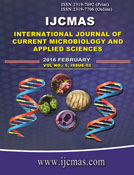


 National Academy of Agricultural Sciences (NAAS)
National Academy of Agricultural Sciences (NAAS)

|
PRINT ISSN : 2319-7692
Online ISSN : 2319-7706 Issues : 12 per year Publisher : Excellent Publishers Email : editorijcmas@gmail.com / submit@ijcmas.com Editor-in-chief: Dr.M.Prakash Index Copernicus ICV 2018: 95.39 NAAS RATING 2020: 5.38 |
Land sources are becoming limited as the population size is increasing day by day. Due to mining and related activities the soil and water resources gets damaged, contaminated and polluted. The overall environment gets disturbed and looses its green cover exposing more area to erosion. To meet the challenge, the focus is on to reclaim the degraded land and understands the complexities and interactions of soil biological system and agro-ecosystem as a whole. Bio-fertilizers play a very significant role in improving soil fertility. Lack of region specific strains is one of the major constraints in popularizing the bio-fertilizer as these are not only crop specific but soil and region specific too. Therefore, in the present investigation indigenous species of cyanobacteria was isolated from cement mining wasteland. The physico-chemical analysis of the mined and agricultural fields revealed structurally unstable and poor status of micro-and macro nutrients. The diversity indices of the area also revealed the presence of only few species belonging to genus Nostoc (5 species), Anabaena (1 sp.), Cylindrospermum (1 sp.), Hapalosiphon (1sp.). The genus Nostoc was found to be most dominant with 5 isolates and 62% occurrence followed by other genera represented by one species and 12.5 % of occurrence.
 |
 |
 |
 |
 |